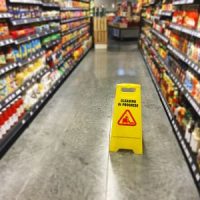How Long Must A Safety Hazard Exist For A Store Owner To Have “Constructive” Knowledge?

The key to any premises liability lawsuit is establishing the property owner had “actual or constructive knowledge” of the safety hazard that injured the customer. For example, if you are injured in a slip-and-fall accident caused by spilled water on a supermarket aisle, you need to show that the management either knew the spill existed prior to your fall (actual knowledge), or that the spill had been around long enough that management should have known something was wrong (constructive knowledge).
Judge: 10 Minutes Not Enough Time for Wal-Mart to See Spilled Liquid
But just how long is long enough to establish constructive knowledge? A recent decision from a federal judge in Miami, Hernandez v. Sam’s East, Inc., offers some guidance on this subject. In this case, the plaintiff was shopping at a Wal-Mart in Miramar, Florida. While walking down the produce aisle, the plaintiff slipped and fell on a “transitory liquid substance.” She subsequently sued Wal-Mart for damages.
Wal-Mart successfully moved to have the case dismissed. The company argued it lacked constructive knowledge of the spilled liquid prior to the plaintiff’s fall. The judge agreed there was “no evidence” that the store’s management could have reasonably known about the hazard beforehand.
The judge explained that under Eleventh Circuit case law, which applies to federal cases in Florida, constructive notice “is established when the hazard exists for a sufficient period of time that a defendant should have eliminated the danger.” Florida state courts have further elaborated that “15 to 20 minutes is a sufficient amount of time to charge a premise’s owner with constructive knowledge of a dangerous condition.” And in cases where the dangerous condition has existed for “10 minutes or less,” that is insufficient to establish constructive knowledge.
Here, the judge noted Wal-Mart provided “direct evidence” the spilled liquid that caused the plaintiff’s fall “could not have been on the floor for more than 10 minutes.” This direct evidence came from an employee, who testified he personally “walked through and inspected the area” about 10 minutes prior to the accident, during which time he “did not observe any liquid, fruit, or other substances on the floor.” Wal-Mart’s security camera footage confirmed the employee’s account. Given this, the judge said that whatever the plaintiff slipped on could not have been on the floor for more than 10 minutes, meaning Wal-Mart did not have sufficient time to know there was a dangerous condition on its property.
Speak with a Florida Personal Injury Lawyer Today
Slip-and-fall cases often turn on establishing highly specific factual timelines. That is why it is crucial to consult with an experienced Boca Raton premises liability attorney as soon as possible following an accident. The longer you wait, the more likely you are to forget or overlook crucial details. So if you need to speak with a lawyer today, Contact Leifer & Ramirez to schedule a free consultation.
Source:
scholar.google.com/scholar_case?case=6570442550071151802


